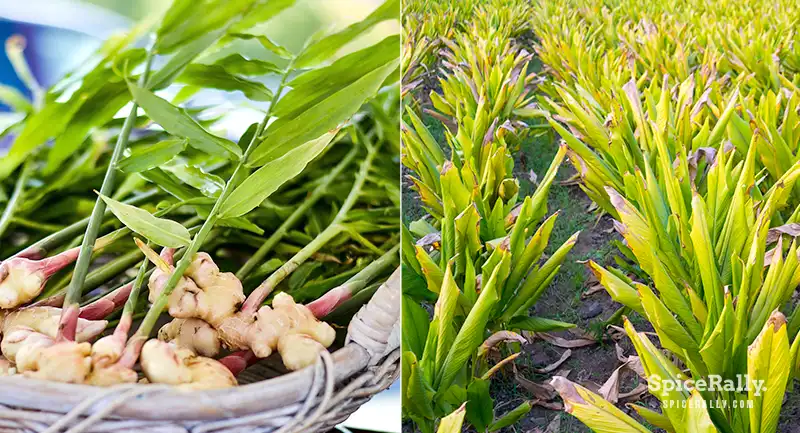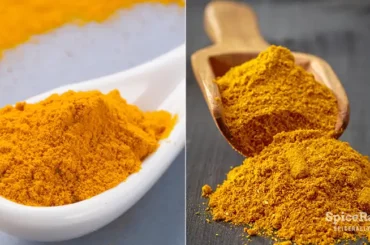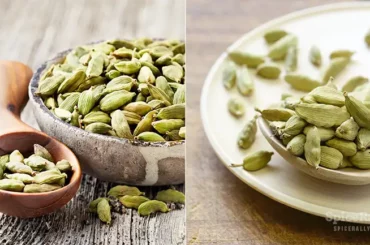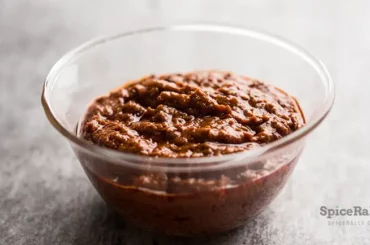Ginger is a spice that gives a distinctive pungency to most of our dishes. So, if you are interested in having your own cultivation, here’s a complete guide on how to grow ginger.
Ginger is a tropical plant that requires well-drained soil to grow, and they succeed from rhizomes. You can grow ginger indoors in wide, deep pots. Or else, choose a frost-free location in your garden with adequate sunlight and shade.
So, read ahead to get accurate information on how to grow ginger at home and get a wholesome harvest!
How To Grow Ginger?
Having a ginger plant at home is like a jackpot that gives you the fortune of flavor, aroma, and tons of health benefits. In fact, you can also save a lot of money that you spend on ginger when you have your own cultivation at home- ginger gives you an indefinite harvest!
As a tropical plant prone to Asian soil, you must be thinking if this can even grow in Western countries. On the bright side, when you provide your plant with the right soil type, water them as needed and give them the right amount of shade and sunlight, you also can be a proud owner of a successful ginger harvest!
It will not grow outside every month of the year in USDA Hardiness Zones 8 and down. If you live in USDA Hardiness Zone 9, 10, or 12 and temperatures do not drop to or below 32 degrees, you can efficiently grow ginger outdoors. And the rest of you can grow in pots/containers or dig before frost.
However, there are a few places in the USA where ginger grows year-round, and they are:
- Southern Texas and Louisiana
- Southern and coastal California, Central Valley
- Florida
- Hawaii
- Southern Arizona
The season is very important when growing ginger. It produces the best in summers and the best time to plant ginger is the mid-spring. It takes about eight to ten months for ginger to sprout. So, if you grow in mid-spring, you can get the harvest in winter.

Plant Description
Ginger (Zingiber officinale) is a vertical, herbaceous perennial plant in the family Zingiberaceae. The aloft-ground shoot is upright and reed-like, with unbent leaves positioned irregularly on the stem. The shoots emanate from multiple bases and encase around one another.
The leaves can get about 2.75 inches in length and about 0.7 inches in width. Flowering leads are carried on shorter stems, and the plant delivers cone-shaped, pale yellow flowers. The ginger plant can go about 2–4 feet in height and is developed as an annual plant and is considered to have originated in Southeast Asia.
This tropical plant grows best in sunny and warm climates. They succeed in deep but well-draining soil that is rich in organic matter. The best soil pH for the growth of ginger is between 6.0 and 6.5. And the plant demands a minimum temperature of 15.5°C (59.9°F).
Ginger plants need an average annual rainfall of 250 and 300 cm for their best maturation. Moreover, the growth requires supplementary irrigation where rainfall is insufficient and will not endure waterlogged soils.
I grow plants for many reasons: to please my eye or to please my soul, to challenge the elements or to challenge my patience, for novelty or for nostalgia, but mostly for the joy in seeing them grow.
David Hobson
How Can I Grow Ginger At Home?
Even though ginger comes from a heat, water, and humidity-loving atmosphere, growing it in a non-tropical zone is still possible. The best thing about this plant is that it is self-sustaining, low maintenance, and gives a healthy yield when provided with the right amount of water, shade, and light.
As mentioned previously, ginger takes up to ten months to mature, and it doesn’t endure frost. If you live in an area that gets really cold in the winter, you can grow these in a pot indoors and take them outdoors in the summertime. These plants grow well in partial to full shade, making it a plus point to grow effortlessly indoors.
How To Grow Ginger Indoors?
01- Preparation
Choosing a healthy rhizome is a crucial factor for the success of your plant. Thus, you need to pick up a living, wholesome rhizome, and you can buy this from your local grocery store, Asian groceries, garden supply store, or nursery.
Make sure the rhizome you chose is fresh, hard, and plump without any marks of mold or blemishes. The skin should be firm, and choose a rhizome with as many eye buds since those are where your plant would sprout.
Try to get an organic ginger rhizome for good reasons. But if you can’t find one, ensure to soak your ordinary rhizome in water overnight to remove as much growth inhibitor as possible. If you are lucky enough, you could get a seed ginger rhizome that is prepared for planting.
Another important fact to remember is that the larger the rhizome chunk you plant, the faster you will get your harvest. The reason is that you will get more shoots if only there are enough areas for the sprouts to come up.
Hence, planting a bigger ginger rhizome will make more shoot development top and root growth down below quicker, which means more photosynthesis, energy, and growth, resulting in a faster ginger harvest.
02- Setting The Pots And Planting
Ginger plants usually grow horizontally. Therefore, a wide, shallow pot would be the ideal choice. Get a plastic or ceramic pot that is at least 12 inches wide and 12 inches deep.
You can go for a deeper pot if you use gravel in the bottom to facilitate drainage. Make sure the pot you picked has really good drainage holes to prevent waterlogging. Keep a relatively deep saucer under the pot to collect the water that drains.
When choosing the potting soil, it is vital to use a high-quality mix. We recommend the Miracle-Gro Potting Mix, which is somewhat loose but really rich in organic matter. It is important to choose soil that drains well to maintain the health of the ginger roots.
Place the ginger rhizome in the soil with the eye buds facing upwards. After you have filled your pot, punch the ginger root into the soil.
And if you are planting more than one root in your pot, you should set them at least 6- to 8-inches apart so they have sufficient room to grow. Cover the rhizome with 1- to 2-inches of soil over it. The soil should cover the entire rhizome.
03- Watering
Be generous with the watering. You want to ensure that the rhizome you planted has adequate water to grow. Fill a watering can with clean water and spray enough on the soil to moisten it thoroughly. While you need the soil to be watered sufficiently, ensure it is not over-soaked. Be sure that all the water is completely absorbed, so there aren’t any waterholes on the surface.
04- Placing The Potted Plants
After planting the rhizomes and watering them, you need to find the perfect spot in your house to keep your ginger plants. The perfect temperature for the location where you keep the ginger plant is 16 to 32 degrees Celsius (60 to 90 degrees Fahrenheit).
Accordingly, you need to find a warm area where your plant does not get disturbed by direct sunlight. Make sure your plant receives partial shade.
05- Taking Care Of Your Ginger Plants
Continue to keep your ginger plant in a warm, partially shaded place and water regularly as it grows, assuring the soil remains just moist. You can fill a spray bottle with water and sparingly mist the soil daily.
Moreover, you can also water it twice a week using a watering can instead of misting it daily and ensuring the soil dries out between waterings.
In addition, monthly nourishing your plant with rich compost will provide healthy stem growth. You can essentially sprinkle 3- to 4-inches of compost over the soil’s surface once a month.
By the inception of the summer months, you can move your plant outside. This is not compulsory, but you can still do it if you can protect your plants from cold winds. If growing your ginger outdoors, move it back indoors when temperatures start to drop in autumn.
How To Grow Ginger Outdoors?
Ginger grows outdoors year-round if you live in a warmer climate. However, you should make sure that the soil is entirely frost-free, well-drained, and loamy before planting your rhizomes. Your outdoor plants need partial shade with about two to five hours of sun daily.
After sourcing the ginger rhizomes as mentioned above, you can plant them in raised and set beds, plunging the rhizomes in double rows one foot apart with a working track between the rows. Water the soil really well until it gets thoroughly moistened.
You will see the leaves emerging after about one week’s time. And you should be watering the plants moderately but deeply after seeing the growth.
Protecting Your Indoor And Outdoor Plants From Physical Damage
When your ginger plants do not receive the right amount of water and sunlight, they will show indications that they aren’t healthy. It is important to keep an eye on the color and texture of the leaves of the plants so that you can fix problems as soon as they occur.
If the leaves of your plants turn yellow, it is usually an unhealthy sign that you are overwatering them or the soil is not draining appropriately. Therefore, cut back on how frequently you water the plant and monitor the pot’s drainage holes to make sure that they are not obstructed.
If the leaves begin to appear dehydrated or scorched, it usually signifies that the plant is receiving excessive direct sunlight. In such instances, you can move the plant to a spot where it doesn’t get direct sunlight and trim away the affected leaves.
And if the leaves grow brown ends, it is usually an indication that you are using too much compost or fertilizer. Then, it would be best if you were careful only to put compost once a month.
Harvesting Indoor and Outdoor Plants
If you need to grow ginger, you should be super patient as it takes up to ten months to give you a healthy harvest. Stay until the plant has been growing for several months.
And after two to three weeks of planting, you will start to notice shoots popping up through the soil. But it won’t be prepared for harvesting until 3-4 months after the sprouts appear.
Generally, the ginger is ready to harvest when the stems above the soil are around 3- to 5-inches tall. When you are prepared to gather your harvest, use your fingers to move some of the soil aside from the border of the pot. Find a ginger rhizome, and use a small knife to prune off a piece of the ginger.
After you are done cutting off some of the ginger, relocate the rhizomes in the soil. Make sure they are completely encircled with soil so they will continue growing. Keep misting the soil with water daily and adding compost to the pot each month to maintain the plant’s growth.
Wash off the dirt from the rhizomes before using them. You can keep your homegrown fresh ginger for up to two to six months when stored in the refrigerator or the freezer.
Ginger Is A Plant Which Is Absolutely Worth Having A Spot In Your Garden!
As you see, growing ginger in your home garden or inside your house is not as difficult as someone would think it would be. Once you choose a healthy rhizome to be planted, you can set your pots with good quality soil and plant them, providing them with the right amount of water, shade, and light.
And, if you have enough space in your garden, you can grow them the same way in raised beds, ensuring that the soil is well-drained and the spot is partially shaded. Watering and keeping a closer eye on your plants will enable healthy growth. You can get a successful harvest in around ten months if your plants are well-cared.
Related Topics
- How To Grow Turmeric Indoors And Outdoors: Instructions And Guides
- Turmeric vs Ginger: This Is The Difference You Should Know
- Ginger vs Galangal- Things You Need To Know About These Two Rhizomes!
This post may contain affiliate links. If you use these links and make a purchase, We may earn a small commission. However, there’s no extra cost to you. Also, as an Amazon Associate, we earn from qualifying purchases. Thanks!




